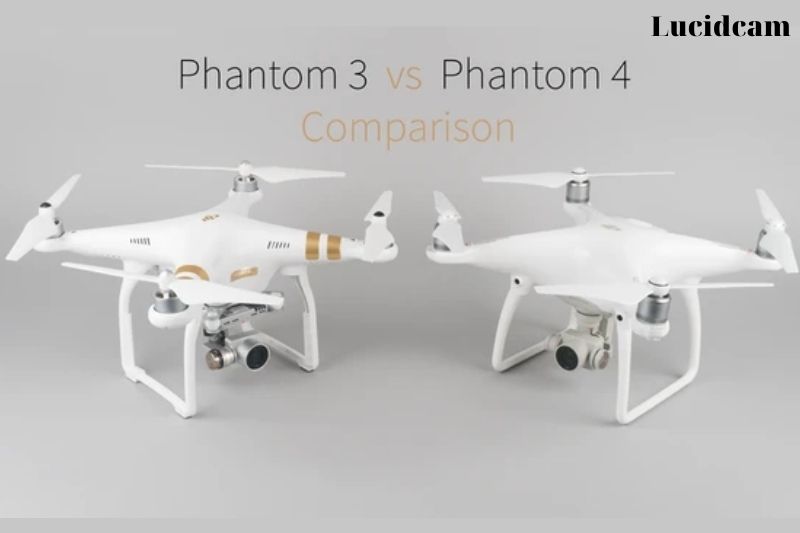The Phantom 4 and Typhoon H are both high-quality drones with a lot of great features. The Typhoon H has an impressive flight time of 27 minutes, while the Phantom 4 can fly for up to 30 minutes.
The Typhoon H is made out of more lightweight materials, making it easier to carry around when traveling. But if you’re looking for a drone that offers more advanced camera capabilities, then the DJI Phantom 4 is probably better suited for you.
In this blog post comparison, Lucidcam will look at which features each drone offers, their pros and cons, and how they compare at price so you can decide which one best suits your needs!
Table of Contents
- 1 Phantom 4 vs Typhoon H
- 1.1 DJI Phantom 4
- 1.2 Yuneec Typhoon H
- 1.3 Design
- 1.4 Weight
- 1.5 Size
- 1.6 Remote Control
- 1.7 Obstacle Avoidance
- 1.8 Battery Life
- 1.9 Range
- 1.10 Rotors/Motors
- 1.11 Retractable Landing Gear
- 1.12 Camera
- 1.13 Performance
- 1.14 All Package
- 1.15 Intelligent Features
- 1.16 DJI Phantom 4 vs Yuneec Typhoon H Carrying Case
- 1.17 Software User Experience
- 1.18 Essential Hardware Functionality
- 1.19 Essential Video Functionality
- 2 Conclusion.
Phantom 4 vs Typhoon H
DJI Phantom 4
Pros
- High quality, sturdy materials
- Weight
- Nice camera sensors
- Flight time
- Bigger online community
- Flight ranges up to 2,000 miles
- Incorporation of smart detection technology
Cons
- Additional accessories can be expensive.
- You will need a smartphone or tablet to use the transmitter
- Fixed landing gears
- It’s small and easy to see from the air, but it’s hard to spot when high up.
- No 360 degrees Anti-Collision avoidance-System
Yuneec Typhoon H
Pros
- Arms Folds
- Retractable legs
- Modular design
- It is easy to see from afar
- The remote controller has integrated a 7-inch LCD screen
- 360deg rotation camera
- 4k camera CGO3+
- Intel object avoidance technology
- Can be used to transport heavier payloads
Cons
- Smaller flight distance
- Filming quality is lower
- Few accessories available
- The top speed is lower
Design
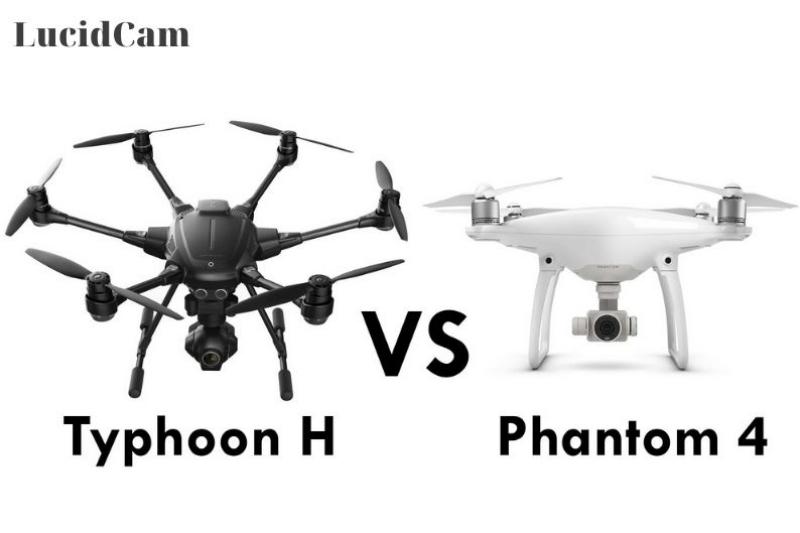
The DJI Phantom 4’s skeleton is made of high-quality magnesium. This reduces vibrations during flight. The skeleton helps to move the drone’s weight towards its center of gravity, increasing stability and balance in the air.
Yuneec Typhoon H has a carbon fiber arm and a plastic body. Typhoon H’s carbon fiber arms allow it to be light but strong in flight. This helps reduce vibrations and keeps images steady.
The Typhoon’s ability to retract and fold its arms down is a significant design difference between the drones. This greatly enhances Typhoon H’s portability and ease of use.
The DJI Phantom4 has 4 propellers while TyphoonH is compelling through the hexacopter design and the aggressive shape and appears to look like a professional tool. It is equipped with 6. Six propellers on Yuneec TyphoonH give the drone greater stability. It can adjust to fly and take off if one motor is damaged.
Weight
- DJI Phantom4: 3.04 pounds
- Yuneec Typhoon H: 4.3 pounds
A difference of more than one pound is significant. It is no surprise that the Phantom is quicker and has a longer flight duration. It was heavy to transport the Typhoon H in the box for extended periods of time.
Size
With its white body, rounded edges and white paint job, the Phantom 4 keeps its original look. It’s light and easy to transport with auto-locking and removable propellers.
Although I declared Yuneec as the winner of the airframe design contest, I have yet to see it in person. The Phantom is smaller. Although size doesn’t really matter for professionals working on the film, regular consumers might not want to take this bag on a trip abroad or to take it along to a picnic. Because I am a small person, I believe that smaller is better.
Remote Control
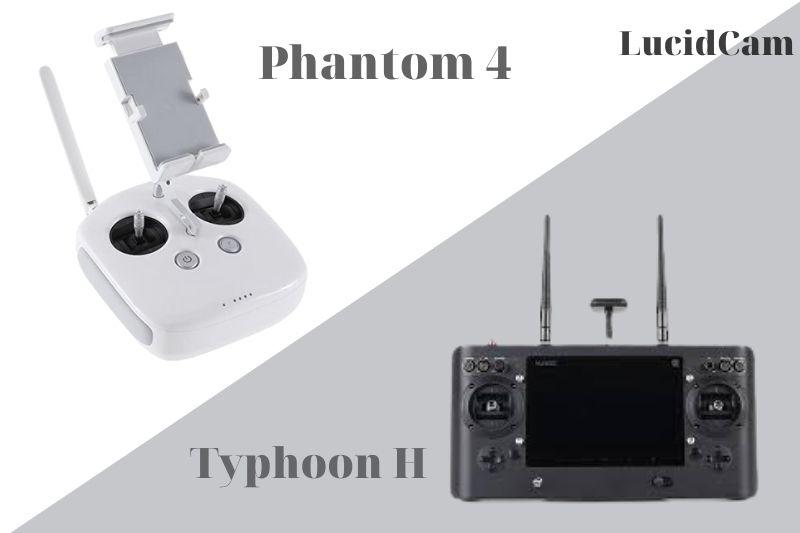
Typhoon H
Yuneec TyphoonH controller features a large screen in the middle that acts as a mobile device running Android. There are buttons and switches all over the device. It has a major drawback: the manufacturer placed the motor start and landing gear buttons on the backside, making it difficult to reach.
Another great thing about this controller is the fact that you can also connect a second remote controller. This means that one person controls the flight while the other controls the camera.
A full-sized HDMI out port is available on the Yuneec TyphoonH transmitter. This is a very important feature because you can view the image on an external screen directly from the HDMI port.
The maximum range for Typhoon H is 1600m (5249ft).
Phantom 4
It looks almost identical to the earlier versions. It does have some distinctive features worth mentioning, including the Sport Mode, which allows users to fly at 45 mph, TapFly Mode, which allows you to go to a specific place in 3D space, Smart Mode, which allows for easy circles around fast-moving objects without needing 2 pilots, and the DJI Active Track Mode, which allows you select an object or area from the DJI Go App and let the drone follow it.
You get a nice and simple remote with only the essentials with the Phantom 4. You get all the buttons you need for adjusting the camera exposure, capturing photos, and shooting videos.
The gimbal tilt wheel works flawlessly. DJI’s app to operate the drones is very good and any decently fast mobile device will work, you will need a smartphone or tablet. DJI’s app for controlling the Phantom4 drones works well on any mobile device. The DJI Phantom4 isn’t able to fly as far as its predecessors. It still easily hits 5000m (16404 feet).
Obstacle Avoidance

Any operator who wishes to avoid potential damage from a crash will be greatly helped by a drone equipped with an obstacle avoidance system.
The Phantom 4’s obstacle avoidance system is unique and includes five cameras (one main camera and two front and bottom cameras). This allows the drone to better examine its surroundings and minimizes the risk of crashing when flying backwards or to a side with limited visibility. Phantom 4’s obstacle avoidance system can detect objects as far away as 50 feet. Additionally, the Visual Positioning System (VPS), which is a non-GPS device, has been improved to work at heights up to 33 feet.
The Typhoon H boasts an obstacle avoidance system with an ultrasonic system named RealSense. The Typhoon H employs sonar sensors that bounce sound waves off objects back to the drone’s front sensors.
Battery Life
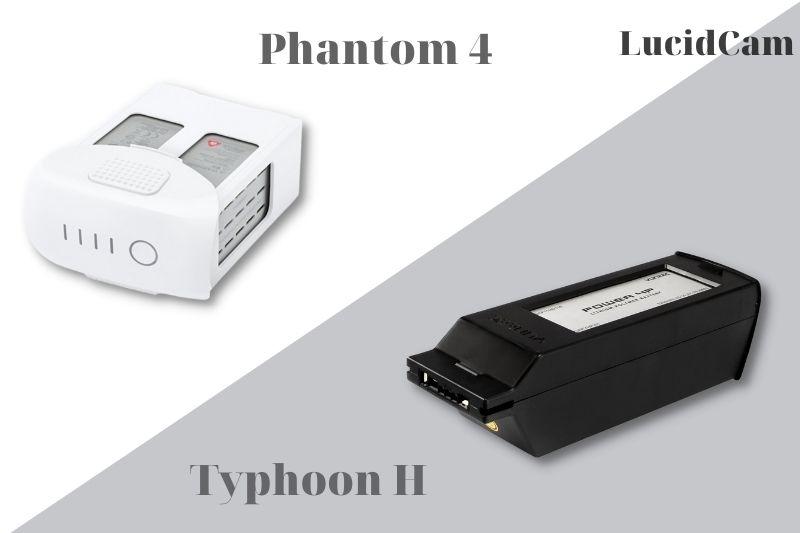
Phantom 4
The Phantom4 can fly for approximately 3 minutes longer than Typhoon H. The Phantom4 can fly up to 28 minutes, while the Typhoon H only can fly for 25 minutes. The battery of the Phantom4 is equipped with a battery indicator. This feature is not available on Typhoon H.
These drones are very stable and have a long flight time. The Phantom 4’s four-cell Li-Po Li-Po Li-Po battery has a 28 minute flight time. This drone’s battery seems smarter, and it has only four rotors, which helps with the flight time.
Typhoon H
Typhoon H battery doesn’t look bad, and they are about $40 less.
It has a 14.8V 5400mAh Li-Po 4S battery that can fly for approximately 25 minutes. The Typhoon H’s battery latches into the drone with a much smaller force than the Phantom 4. This battery has one major drawback: it doesn’t have an onboard charging unit or battery life indicator like the Phantom4.
Many users may find it difficult to determine how much power each battery has left before putting it in their drone. The charge time for the Phantom4 is also slower than the Phantom4.
Range
The range of each drone is different. The Phantom 4 uses its own Lightbridge system, which allows it to travel up to 5km. The flight controls for Typhoon H, however, are done over a separate link that has a range of 1.6 km and transmits a video feed over Wi-Fi.
Rotors/Motors
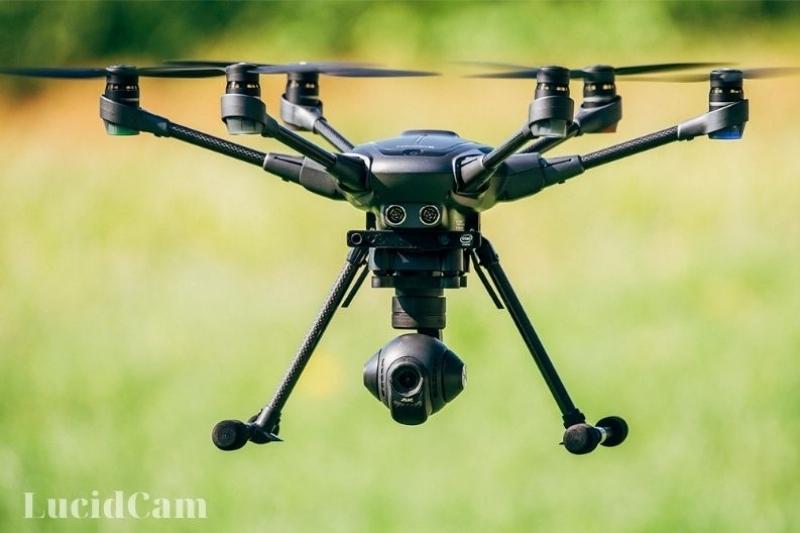
The Typhoon-H’s six propellers are used by the Phantom 4, while the Phantom 4 uses four. The Phantom 4 has four propellers, while the Typhoon H has six rotors. This means that it is smaller and more complex than Typhoon H. However, It does not have redundancy. The Phantom 4 is a great choice if you are looking for a small form factor. The Typhoon-H’s six motor configuration is a good choice if you need more redundancy.
Retractable Landing Gear
The retractable landing gear is a major selling point on TyphoonH. It allows you to rotate the camera 360° without having to use any landing gear. This is important for dual operators (pilot and gimbal operator), but a single operator can turn the Phantom 4 just as well as panning the camera independently from the drone
The Phantom 4 is the best machine if you are looking for simple shots that don’t require planning or complex camera moves. The Typhoon-H is the best choice if you are looking to do more dynamic or complex camera moves using a dual operator setup.
Camera
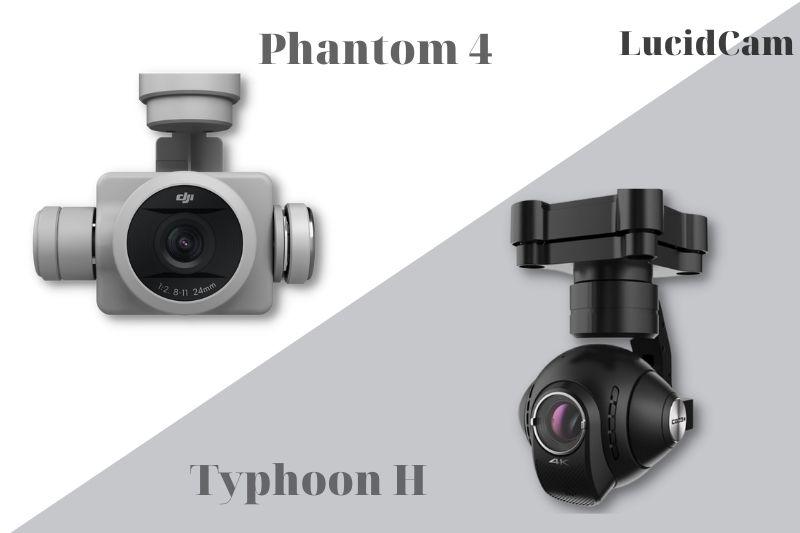
Professional aerial photographers will find both drones useful and have non-detachable 12MP cameras that can be connected to three-axis gimbals. Both drones can deliver crisp, clear aerial footage at a maximum frame rate (30 frames per second). These drones also have basic camera controls such as ISO, shutter speed, white balance. When filming in full HD, you can create slow-mo shots at 120 frames per second. Both drones have excellent video quality. The Phantom 4 produces a smaller image (20mm) with a 94deg field-of-view.
The Yuneec Typhoon H lens has a wider field of view than the GoPro (14mm, 115deg). Action junkies prefer the wide-angle, while cinematographers opt for longer focal lengths. It is also important to remember that the DJI Phantom 4 uses a fixed camera, while the TyphoonH rotates 360 degrees. The 360-degree rotating camera is a huge advantage for operators wanting to concentrate on getting the perfect shot. This feature is particularly good for capturing cinematic shots.
The DJI Phantom 4 is serious about video controls. You can use the drone’s LOG color profile to have more control over color grading. There is also an overexposure warning setting (zebras), sharpness, saturation adjustments. The DJI Phantom 4 has a histogram, visual grids, and guides for better shot framing.
Performance
In terms of speed and agility, the Phantom 4 is faster than the Typhoon H. The Typhoon H is capable of flying up to 35km, while the Phantom 4 can travel up to 72km in Sports Mode.
The Typhoon H cannot fly higher than 1.6 km, while the Phantom 4 can fly up to 72 km in Sports Mode. The Phantom 4 is faster than the Typhoon H. Typhoon H also seems to change direction slower, especially when going fast and turning, but the Typhoon H is more stable and can make smoother turns. This is an advantage for filming.
All Package
Typhoon H comes with remote control, the Wizard (a secondary remote), a charger, one battery, and ten propellers. The Typhoon H comes with a touch screen built into the controller, which is a big plus.
One battery, one remote control, a charger, and a case are included in the Phantom 4 package. Although the Phantom does not include an iPad or tablet with it, the case for Phantom 4 is very durable and robust and made from high-quality Styrofoam material.
Intelligent Features
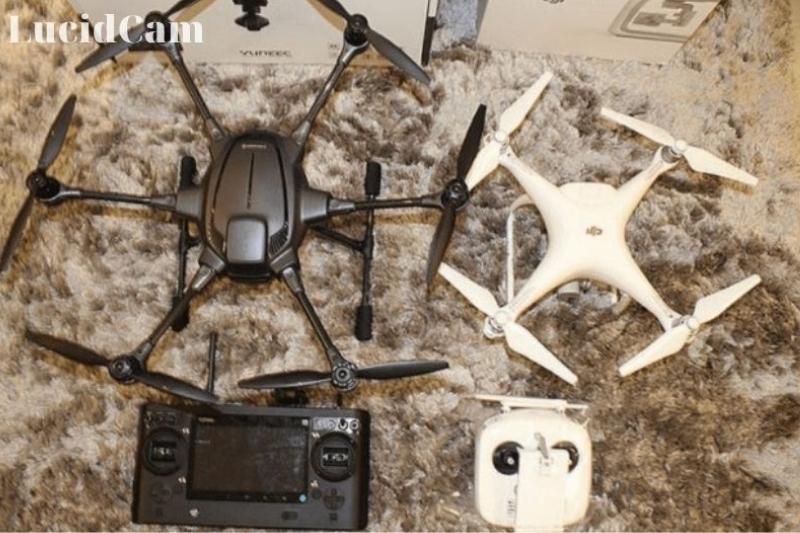
Both the Phantom 4 and Typhoon H come with unique intelligent flight modes. Six intelligent flight modes are available on the Typhoon H: Orbit Me; Point of Interest; Journey; Curve Cable Cam, Follow Me, and Dynamic Return home.
Orbit Me mode allows users to make their drone circle the pilot. TyphoonH will follow an operator in this mode, even if they move around during the shot. The operator can use Journey to take an aerial selfie. This will allow the drone to fly 150 feet in front of them, capturing the perfect in-air selfie shot. Curve Cable Cam allows users to create waypoints that direct the drone along an invisible route with pre-set coordinates.
Tap to Fly, Follow Me, and Active Track are some of the innovative flight modes available on the Phantom 4. The Phantom 4’s Sports Mode allows it to fly at speeds of up 72 km/h while maintaining its Visual Positioning system. Tap to Fly allows users to tap any location on their screen with the DJI Go app to have their drone flies to that spot automatically. ActiveTrack allows operators to tap on an object on their screen and have the drone follow it autonomously. This will keep the object in the center.
DJI Phantom 4 vs Yuneec Typhoon H Carrying Case
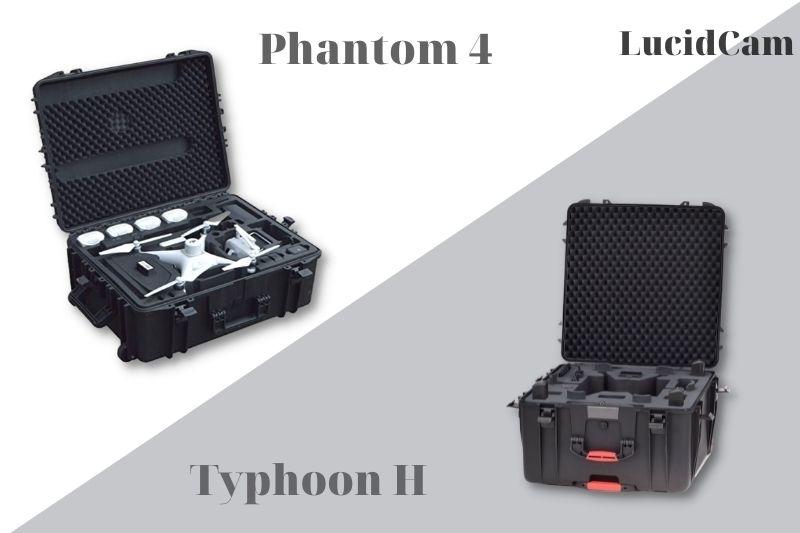
As my carry case, I use the exact same box that the Phantom 4 arrived in. The latch seals the box shut. It is made of styrofoam, so it might not be safe for you to carry it to the airport. However, for film shoots and family picnics, it’s great.
Although the Typhoon H case is ideal for storage, its lid is thin, and it lacks a handle. It’s not the best choice if you have to carry it long distances. I found it uncomfortable walking from my San Francisco apartment to the MUNI (our subway) and then to Golden Gate Park. Although the Typhoon H backpack has been sold separately, it is currently available on the market. I will review it when it arrives. That should eliminate any issues with the backpack being carried around.
Software User Experience
Although I don’t want to complain about Typhoon H in every section immediately, the software is just as important as hardware. DJI is far ahead of Yuneec here.
Basic Functionality: While the DJI Go app is not perfect, it does a great job of organizing a lot of features in a well-organized space and without making it seem overwhelming. The interface controls are simple and consistent, and most things are exactly where you’d expect them to be. You can even use the flight simulator to talk to your drone and put it in simulation mode. This allows you to test basic features such as return-to-home, course lock, waypoints, and attitude mode before taking off for your first flight.
The Typhoon H app works well. It does what it is supposed to, runs fast, and doesn’t crash. All of your important flight information is visible in the corners. There are many little details that can be overlooked or not clearly understood when flying a DJI drone. Maps are one example. These maps don’t exist in Typhoon H. All you have to help you find your way home is a little green Arrow overlayed on the video feed.
Essential Hardware Functionality
The Flight experience: I haven’t had any issues with these drones so far that they are unusable or unreliable. Both drones fly very smoothly and predictably. However, I noticed that the Typhoon H was not as fast in sport mode as the Phantom 4. It seems to change direction faster. This is most noticeable when it’s turning fast. It seems to turn much faster than the Phantom, almost as though it were an ice car. It’s not like Phantom 4’s Phantom H, but if you don’t compare it to that, you won’t notice any difference. It’s just different.
Typhoon H’s ability to raise the landing gears was something I loved about it. The landing gear is not visible in most of my shots on the Phantom. However, it can be annoying when I do. When I do downward facing shots, where the drone is flying side-by-side at high speeds or in high winds, the only time I see the landing gears is during the flight. The landing gear is wider on the Phantom 4 than the Phantom 3. This makes it less noticeable, but it’s something I should be aware of when flying very fast.
Operating Range, The Typhoon H isn’t one of the best drones you plan to fly more than 1 mile. You can add directional antennas to your controller, but they won’t get you beyond 10,000 feet. This is a lot farther than what the stock antennas can reach, but the Phantom 3 Pro or Phantom 4 will easily go 15,000 feet without any modifications.
In good conditions, I have reached more than 20,000 feet using the Phantom 4. At those distances, you will run out of battery and lose range. Although you might not need to fly more than 3-4 miles with your drone in good conditions, having extra power allows you to fly around and around buildings and receive a stronger signal.
Essential Video Functionality
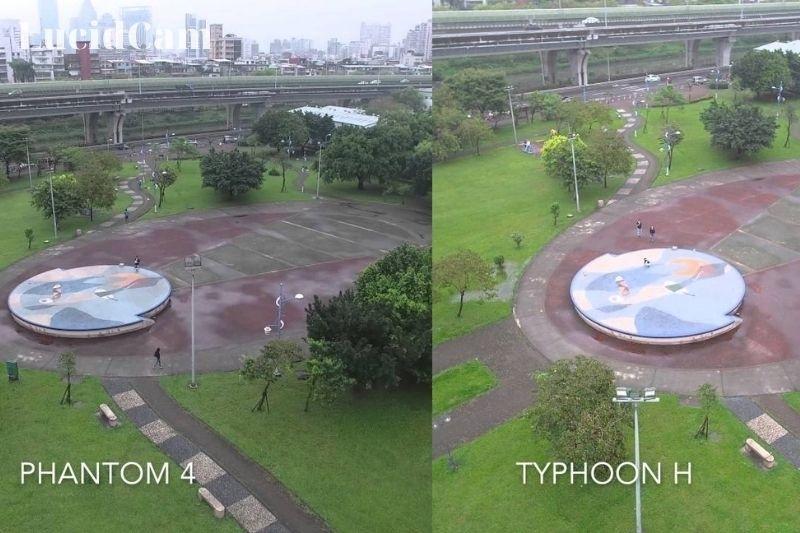
Camera Control This comparison is made from the perspective of a filmmaker. Getting a good video should be your top priority. Both drones have basic camera controls such as white balance, shutter speed, and ISO. You can also choose from a variety of frame rates and video resolutions, as well as a few unimportant color filters. But that’s about it.
The Phantom 4 is serious about video controls. It offers features such as a histogram and an over-exposure warning setting (zebras), sharpness, saturation adjustments, visual grids, and guides for better shot framing. There’s also a real LOG profile that allows for greater flexibility in color grading.
This is the most important area. If one drone produces better videos than the others, almost every flaw or feature could be overlooked. Both drones have great video quality. However, the Yuneec lens has a larger GoPro-style field of view. This makes the Phantom’s image look less impressive.
These features won’t be important if you are just purchasing drones to entertain yourself or capture your child’s first ride on a bicycle. But if you want to get the best aerial shots possible, these additional settings will make a big difference to a filmmaker or enthusiast.
Conclusion.
These drones are incredible. It is amazing to see drones becoming easy and safe to fly. It is difficult to give a blanket recommendation for one drone over the other. These drones are both excellent products. It all boils down to your specific needs.
The Phantom 4 is a great option if you are looking for something that can be carried on a daily basis. The Phantom 4 comes with a very lightweight carrying case that is smaller than a large tote bag.
However, if you want to fly in a high-risk area in order to capture professional video footage then I would recommend Typhoon H. It can record 360deg video, connect easily to the remote controller, and has extra propellers.
Read More:
- Phantom 4 Pro vs Inspire 2: Which Is Better For You
- DJI Phantom 4 Pro Vs Mavic 2 Pro 2023: Which Drone Is Better For You?
- DJI Phantom 3 Vs Spark 2023: Which Is Better For You?
- DJI Phantom 3 Pro Vs 4 Pro 2023: Which Is Better For You?
